I got up early Saturday morning, planning to take the bus up to the Donghwa Recreation Area on Palgong Mountain (near Donghwa Temple) for the purpose of riding the cable car up to the top of the mountain in order to do some hiking along the ridge. Well, best laid plans and all that...
For some reason I got on the Palgong 1 bus instead of the Rapid Bus 1. I realized this when, about halfway up Palgong Mountain, the bus turned off the large, well-traveled, main road and turned onto a steep, narrow, winding road. I could've gotten off right then and there, but I decided instead to see where it would take me. The road wound up the mountain, and grew very narrow - to the point that whenever a rare car would approach from the opposite direction, it would have to back up and pull into the nearest driveway to allow us to pass. The road paralleled a small mountain river, and passed through mountain farmland and small mountain villages, before arriving at its terminus: an intersection with a larger road high on the mountain. At that point, the last of the remaining passengers disembarked. The driver then parked the bus and motioned for me to exit the bus. I asked him in my broken Korean what time the bus would be going to Daegu. His answer - not containing anything recognizable as a time - was not helpful, not even when I asked him twice more.
I'm fairly certain that the larger road near which the bus had deposited me and my remaining fellow passengers was the road that connects Chilgok (the northernmost part of Daegu) with the Donghwasa area, in which case, going either left or right at that junction should probably have returned me to an area with which I was familiar. However, being "fairly certain" is not the same as being 100% positive, and as the larger road somehow managed to lead uphill in both directions, I opted for going home the way I arrived: walking down the long, narrow, winding road.
For some reason I got on the Palgong 1 bus instead of the Rapid Bus 1. I realized this when, about halfway up Palgong Mountain, the bus turned off the large, well-traveled, main road and turned onto a steep, narrow, winding road. I could've gotten off right then and there, but I decided instead to see where it would take me. The road wound up the mountain, and grew very narrow - to the point that whenever a rare car would approach from the opposite direction, it would have to back up and pull into the nearest driveway to allow us to pass. The road paralleled a small mountain river, and passed through mountain farmland and small mountain villages, before arriving at its terminus: an intersection with a larger road high on the mountain. At that point, the last of the remaining passengers disembarked. The driver then parked the bus and motioned for me to exit the bus. I asked him in my broken Korean what time the bus would be going to Daegu. His answer - not containing anything recognizable as a time - was not helpful, not even when I asked him twice more.
I'm fairly certain that the larger road near which the bus had deposited me and my remaining fellow passengers was the road that connects Chilgok (the northernmost part of Daegu) with the Donghwasa area, in which case, going either left or right at that junction should probably have returned me to an area with which I was familiar. However, being "fairly certain" is not the same as being 100% positive, and as the larger road somehow managed to lead uphill in both directions, I opted for going home the way I arrived: walking down the long, narrow, winding road.
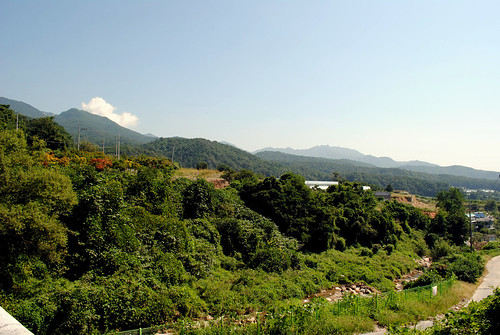
Taken from the "larger road" looking down at the road I'd come up.
It was a perfect day for a long walk in the mountains, sunny and warm (but not hot or humid), with gorgeous blue skies overhead. The walk down took about three hours - although I certainly could've done it faster if I hadn't been continually stopping to take pictures of every little thing: farmland, the river, insects, flowers, dogs, rich mountain chalets, poor rural dwellings, you name it. The entire set of photos can be viewed by clicking here, although here's a sampling for you:
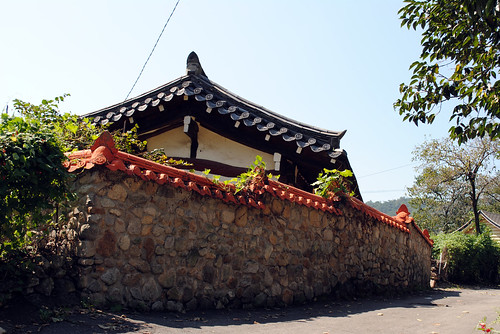
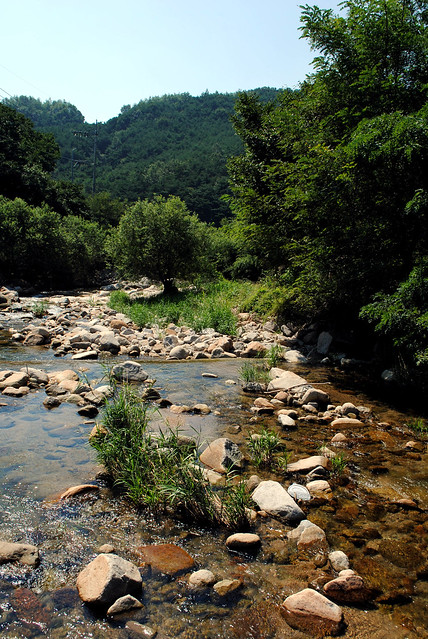
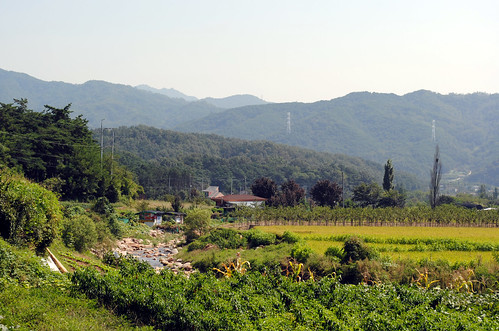
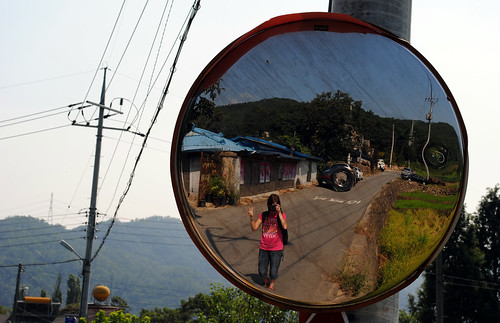
However, by far the most intriguing thing I found on my trek out of the mountain was the Yongsu-dong Dang-san. In the middle of nowhere, about halfway down the mountain, nestled in between the river, the road, and some farmland, was a grove of trees. In the center of the grove stood a large mound of stones, surrounded by several flat altar-like rocks. There was also a sign in both English and Korean bearing the following text:
Koreans have traditionally believed in guardian spirits that protect their villages. A Dang-san is a type of stone altar in a sacred grove near a village where the guardian spirit is believed to temporarily reside. In the hopes of a bountiful harvest and the peace and prosperity of the entire village throughout the year, the people invoked the help of the protective spirit by performing a collective ceremony at the village Dang-san each year. It is said that the Dang-san of Yongsu-dong is some 300 years old, and that it originated when two people, with the family names of Bae and Gu respectively, planted a tree and piled up stones at the entrance to the village, and conducted a ritual at dawn on the 15th day (full moon day) of the first lunar month of the year. Unfortunately, the village ceremony, called Dang-gut, was suppressed as an irrational superstition under the Sae-maeul movement, a government-led modernization movement that was spread throughout the country in the 1970s under the former military dictatorship. Currently, only the old trees and the stone structure are left to remind people of former happier days, but the altar has been maintained in such a good state that it provides a precious asset of historical importance.
Obviously I had to explore it thoroughly and take numeous photographs. If you're interested in seeing the entire group of Yongsu-dong Dang-san photos, click here, although I've included some of my favorites below.
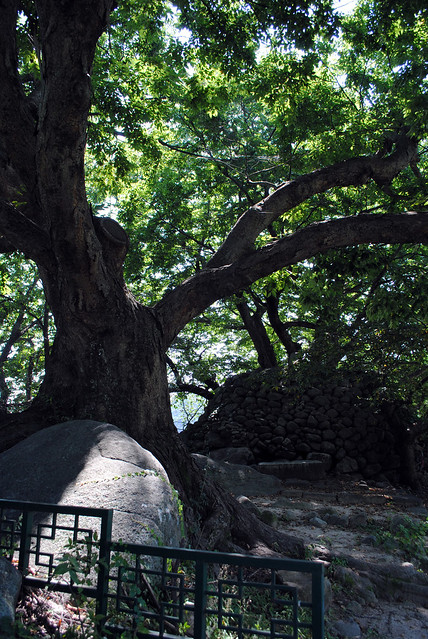
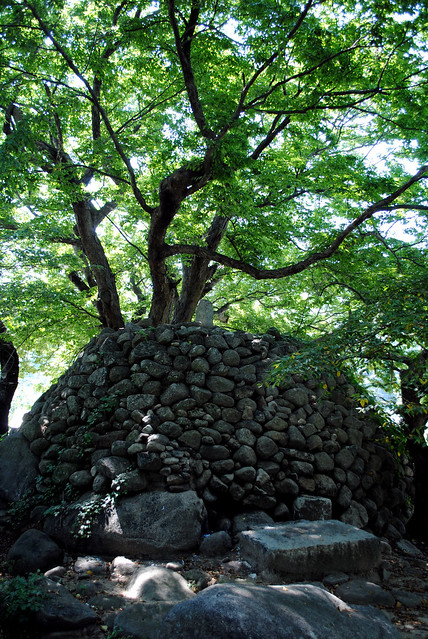
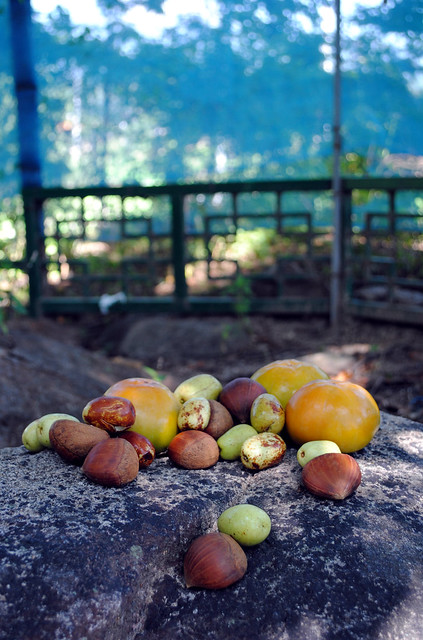
On one of the flat altar-rocks, someone had left an offering of fruit and nuts.
Before I left, I added a packet of crackers, as that was the only food I'd brought.
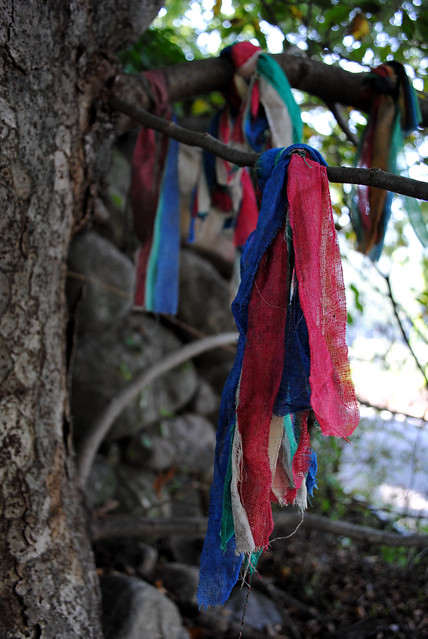
In a couple of places, prayer rags had been tied to tree branches.
The sign had essentially said that worshipping at a place such as the Yongsu-dong Dang-su was a silly superstition no longer practiced in Modern Day Korea - however, the presence of an offering of fruit and nuts, the prayer rags, and even recently melted candle-wax certainly belie its words!

No comments:
Post a Comment